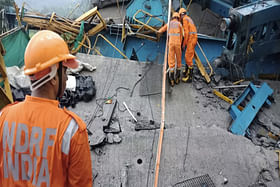As India embarks upon unprecedented infrastructure development, it needs to keep a sharp focus on the challenges that lie ahead.
The accident on Samruddhi Mahamarg in Thane’s Shahapur, around 80 km from Mumbai on 31 July, is a tragic reminder of the challenges that India faces in modernising and expanding its infrastructure.
At least 20 people were killed late on Monday night when a mobile gantry crane, which is used in bridge construction and weighs around 700 metric tonne, collapsed along with the girder from a height of around 35 metres — equivalent to the height of a 10-storey building.
A similar freak accident occurred in January this year, when an under-construction pier rebar of the “Namma Metro” (Bengaluru Metro) collapsed killing a woman and her two-and-half-year-old son.
On 4 June, a 200-metre superstructure of the under-construction Aguani Ghat-Sultanganj bridge over Ganga in Bihar collapsed, claiming the life of a security guard.
Samruddhi Mahamarg is currently in the news. But procedural lapses, negligence and scant attention to safety issues are not confined to any one state or region.
The common thread is that such incidents drive home an essential point —infrastructure projects are the ones which pose the highest safety challenges.
India has an ambitious plan to improve its infrastructure, and in financial year (FY) 2023-24, capital investment outlay for infrastructure has been increased by 33 per cent to Rs 10 lakh crore ($122 billion), which is around 3.3 per cent of the gross domestic product (GDP). The question, then is, how to strike a balance between the scale of expansion, and health and safety record of the infrastructure industry.
Why Things Go Wrong ?
To start with, Occupational Safety and Health Administration (OSHA) standard is not taken seriously in Indian infrastructure projects. OSHA is the globally-accepted quality assurance practice which ensures safe working conditions and also provide adequate training to employees.
For example, the subcontractors appointed for the construction of the third phase of the Samruddhi Mahamarg did not take the necessary precautions for the safety of the workers and due to their negligence, the girder and the launcher fell, the first information report (FIR) said.
Apart from this, contractors don’t feel the need to invest their resources in training or health and safety of the workmen. This is largely because of their temporary status — average retention of workmen in a project is only three to six months.
For many contractors, the health and safety of workers become a priority only after serious accidents, which is also short-lived and after some time, it becomes business as usual.
What makes the matter more complex is that agencies are under tremendous pressure to complete work to meet deadlines. This leads to violation of safety protocols during construction and to add on, the implementing agency often fails to regularly carry out safety inspections of the sites.
Towards Better Safety Measures
In developed countries, the safety standards related to infrastructure project sites have been always high since the early 1970s and has resulted in development of stringent laws and standards for working in such environments.
Between 2017 and 2018, British construction companies faced fines amounting to £19 million due to their violations of safety protocols.
In a welcome change, over the last few years, the industry has come a long way in improving the workers safety, thanks to the entire safety fraternity, industry and government regulatory bodies which have strived hard in this endeavour.
3M India, which focusses on segments including homecare and workplace safety, in collaboration with Directorate General Factory Advice Service and Labour Institutes (DGFASLI) and Ministry of Labour launched mobile safety training centres known as ‘Audhyogik Suraksha Rath’.
These mobile centres travel across states into various sites with a mandate to create awareness and impart training.
Similarly, taking note of several instances of accidents at work sites of highway projects, including collapse of structures and bridges, the Road Transport Ministry has asked its concerned agencies to ensure CCTV surveillance of major structure construction sites.
It has also asked its agencies to carry out third-party proof checks of launching, scaffolding and pre-stressing works.
The highway agencies can withhold 2 per cent of the payment, if the bills submitted do not have the certified documents such as geo-tagged photographs and videos showing how the contractor has followed the construction zone safety norms.
The circular also said in case of repeated default in respect of construction zone safety requirements, this can be treated as deficiency in service and may lead to termination of the contract.
Where Buck Stops
India’s infrastructure is suffering from decades of underinvestment. The gush of investment is essential for lifting India’s growth trajectory, job creation and help realise the goal of turning the country into a $5 trillion economy by 2025-26 — up from $3.5 trillion today.
It is equally true that preventable disasters keep happening because of an unholy confluence of corruption, collusion and callousness. Finally, it is the ordinary citizen who suffers the most.
Therefore, it is crucial that the country balances its approaches and maintains the momentum of infrastructure development while addressing the genuine safety concerns of ordinary citizens, along with their demand for improved safety protocols.
India should adopt good practices from the experience of developed countries, where fatalities are significantly lower and where the health and safety record of the industry has significantly improved in recent years due to their matured management system.
However, the government will have to keep its eye on the ball, and the timeline will likely be longer than it projects.


